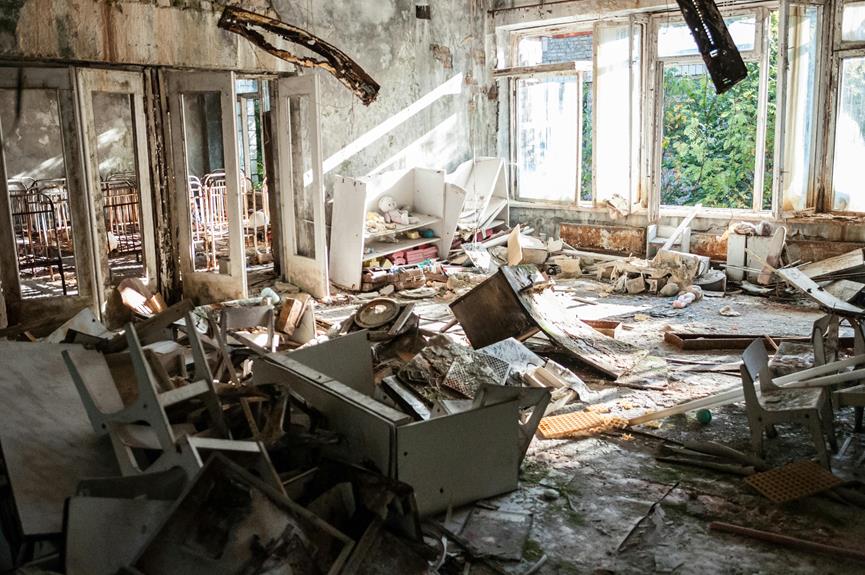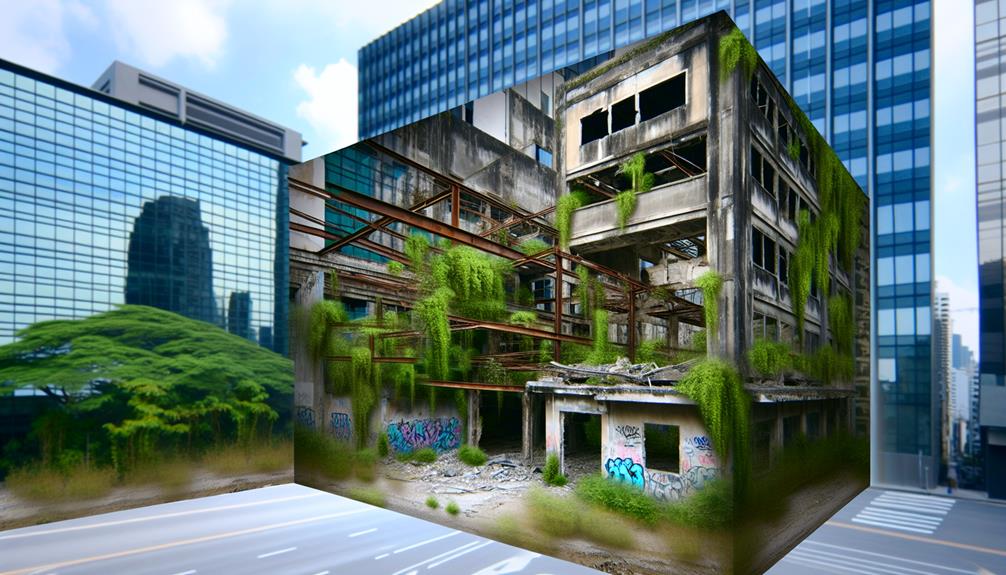Nestled in the shadows of the Chernobyl Nuclear Power Plant, Pripyat, Ukraine, carries a legacy that transcends time. Once a bustling city symbolizing the pinnacle of Soviet urban development, Pripyat's abrupt halt in 1986 left behind a haunting tale of human endeavor and tragedy. As the world turned its gaze away, Pripyat stood frozen in a moment of catastrophe, its abandoned streets and dilapidated structures whispering stories of a bygone era. Yet, amidst the silence and decay, there is a profound allure that beckons exploration and introspection, drawing curious souls to uncover the mysteries that lie within its forsaken walls.
Key Takeaways
- Founded in 1970 near Chernobyl, Pripyat was a model Soviet city with modern amenities and a vibrant cultural scene.
- Evacuated overnight after the Chernobyl disaster in 1986, Pripyat remains frozen in time with abandoned buildings and desolate landscapes.
- The city offers unique urban exploration opportunities, showcasing eerie monuments of its past and the impact of the catastrophe.
- Pripyat's post-apocalyptic landscape, silence, and wildlife reclamation create a surreal and unforgettable experience for visitors.
- Efforts to preserve the memory of Chernobyl include memorial sites, abandoned buildings, and the Chernobyl Museum in Kiev.
The History of Pripyat
Located near the Chernobyl Nuclear Power Plant in Ukraine, the history of Pripyat is a compelling narrative of human settlement and the tragic events that unfolded on April 26, 1986. Before the disaster, Pripyat was a vibrant city with a rich cultural heritage dating back to its founding in 1970. The city was meticulously planned and designed to cater to the needs of its residents, boasting modern amenities and recreational facilities that reflected a thriving pre-disaster lifestyle.
Pripyat was envisioned as a model Soviet city, characterized by its well-organized infrastructure, educational institutions, and cultural centers. The city's architecture blended modernist principles with socialist realism, creating a unique urban landscape that symbolized the aspirations of its inhabitants. Residents enjoyed a high standard of living, with access to parks, theaters, sports complexes, and other communal spaces that fostered a sense of community and belonging.
The cultural heritage of Pripyat was evident in its museums, libraries, and artistic venues that celebrated the region's history and traditions. The city's diverse population contributed to a vibrant tapestry of customs and beliefs, shaping a dynamic social environment that thrived on creativity and collaboration.
Despite the tragedy that befell Pripyat in 1986, the legacy of its pre-disaster lifestyle and cultural heritage endures as a tribute to the resilience and spirit of its people.
Life Before the Disaster
Before the catastrophic events of April 26, 1986, Pripyat thrived as a meticulously planned and culturally rich city, embodying the ideals of a model Soviet urban center. The education system in Pripyat was highly regarded, with a focus on providing quality education to its residents. Schools were well-equipped, and students had access to a wide range of educational opportunities. The city boasted several educational institutions, including schools, technical colleges, and vocational training centers, all aimed at nurturing a skilled and knowledgeable workforce.
Cultural events played a significant role in the vibrant community of Pripyat. The city had a bustling cultural scene, with theaters, concert halls, and art galleries offering a diverse range of performances and exhibitions. Residents of Pripyat enjoyed attending ballets, operas, and theatrical performances, enriching their lives with arts and culture. Festivals and celebrations were also common in Pripyat, bringing people together to commemorate various occasions and foster a sense of community spirit.
Chernobyl Nuclear Accident
In the early hours of April 26, 1986, the Chernobyl Nuclear Power Plant in Pripyat, Ukraine, experienced a catastrophic explosion that resulted in one of the worst nuclear disasters in history. This event had impactful consequences not only for the immediate vicinity but also for the global community. The explosion released a massive amount of radioactive material into the atmosphere, contaminating the surrounding area and causing widespread health issues among the population.
The environmental repercussions of the Chernobyl nuclear accident were profound. The surrounding land became contaminated with radioactive particles, rendering it uninhabitable for humans. Wildlife in the region also suffered, with many species experiencing genetic mutations and population declines. The long-term effects of the disaster are still being felt today, with certain areas remaining off-limits due to high levels of radiation.
The Chernobyl nuclear accident served as a stark reminder of the dangers associated with nuclear power and the importance of stringent safety measures. It prompted a reevaluation of nuclear energy policies worldwide and led to increased regulations to prevent similar disasters from occurring in the future. The lessons learned from Chernobyl continue to inform discussions around nuclear safety and the potential risks posed by nuclear facilities.
Evacuation and Abandonment
Following the aftermath of the Chernobyl nuclear accident, the necessary measures of evacuation and abandonment were swiftly implemented to safeguard the population from the escalating dangers of radiation exposure. The city of Pripyat, once a bustling hub of life with a population of around 50,000, became a ghost town almost overnight. People were forced to leave behind their belongings, homes, and memories as they evacuated the area, never to return. The abandoned buildings of Pripyat now stand as eerie reminders of a tragic event that changed the course of history.
To provide a deeper insight into the evacuation and abandonment of Pripyat, let's take a look at the impact through the following table:
| Evacuation Aftermath | Abandoned Buildings | Impact on Population | Long-Term Consequences |
|---|---|---|---|
| Immediate relocation of residents to prevent radiation exposure | Schools, hospitals, and residential complexes left vacant | Displacement and trauma experienced by evacuees | Loss of homes and community, leading to resettlement challenges |
The evacuation and subsequent abandonment of Pripyat were necessary steps to protect human life in the face of a nuclear disaster. The desolate buildings now serve as a poignant reminder of the resilience of the human spirit in the wake of adversity.
Present-Day Pripyat
The current state of Pripyat, Ukraine, reflects a haunting juxtaposition of its once-vibrant past and the enduring impact of the Chernobyl nuclear disaster. Frozen in time since the evacuation in 1986, Pripyat stands as a poignant reminder of the consequences of the world's worst nuclear accident. The city, once buzzing with urban development and the vibrant lives of its inhabitants, now lies in desolate abandonment, reclaimed by nature as buildings crumble and vegetation takes hold.
Despite its tragic history, Pripyat holds significant tourism potential. The eerie atmosphere and the ghostly remnants of daily life left behind have drawn visitors seeking to understand the legacy of Chernobyl. Tourists are captivated by the striking visuals of Pripyat's decaying structures, such as the iconic amusement park with its rusting Ferris wheel, frozen in time as a chilling reminder of the city's abrupt halt.
Efforts to preserve Pripyat's heritage while ensuring safety for visitors continue to evolve. Strict guidelines and regulations govern tourism activities to minimize exposure to radiation, allowing for controlled visits to explore the haunting beauty of this abandoned city. The delicate balance between promoting tourism and respecting the tragic history of Pripyat remains a challenge, but it is essential in honoring the memory of those affected by the Chernobyl disaster.
Urban Exploration Opportunities
Amid the desolate landscapes of Pripyat, Ukraine, lie intriguing opportunities for urban exploration that offer a unique glimpse into a city frozen in time by the tragic events of the Chernobyl nuclear disaster. The abandoned buildings of Pripyat stand as eerie monuments to a once-thriving community abruptly evacuated in 1986. Urban explorers are drawn to the haunting beauty of this ghost town, where nature has begun to reclaim the man-made structures, creating a surreal juxtaposition of decay and rebirth.
Exploring the abandoned schools, hospitals, and apartment blocks of Pripyat provides a chilling reminder of the human cost of nuclear catastrophe. The empty hallways and crumbling facades tell a silent yet powerful story of lives interrupted and a city abandoned in haste. The iconic Ferris wheel in the amusement park, now rusted and overgrown, stands as a poignant symbol of a place frozen in time.
For those seeking a glimpse into a world untouched by modern civilization, Pripyat offers a rare opportunity for urban exploration. The eerie silence that pervades the deserted streets, coupled with the haunting beauty of nature reclaiming its territory, creates a surreal and unforgettable experience for those brave enough to venture into this post-apocalyptic landscape.
Wildlife and Nature Reclamation
Pripyat, Ukraine, now stands as a tribute to the resilience of nature as wildlife slowly reclaims the abandoned cityscape left in the aftermath of the Chernobyl disaster. Despite the devastating impact of the nuclear accident, the exclusion zone surrounding Pripyat has inadvertently become a haven for wildlife rehabilitation and environmental restoration.
In the absence of human activity, the natural world has begun to thrive once again. The forests surrounding Pripyat are teeming with a variety of wildlife, including elk, deer, boar, wolves, and even the rare European lynx. These animals have found a sanctuary in the deserted buildings and overgrown streets, reclaiming their territory in a poignant display of nature's ability to adapt and rebound.
Moreover, the absence of human intervention has allowed for the regeneration of plant life, creating diverse ecosystems where flora and fauna can flourish. The once desolate streets of Pripyat are now lined with trees and vegetation, reclaiming the urban landscape and transforming it into a green oasis.
As researchers continue to study the long-term effects of the Chernobyl disaster on the environment, Pripyat serves as a stark reminder of both the destructive power of human activity and the resilience of nature in the face of adversity. Through wildlife rehabilitation and environmental restoration, the abandoned city has become a symbol of hope for the future of our planet.
Preserving the Memory
Preserving the memory of the Chernobyl disaster and its impact on Pripyat, Ukraine, is crucial for guaranteeing that the lessons learned from this tragic event are not forgotten. In the wake of the catastrophe, numerous memorial sites have been established to honor the victims and serve as reminders of the devastating consequences of the nuclear accident.
One of the most poignant ways of memorializing the victims of the Chernobyl disaster is through the preservation of Pripyat itself. The abandoned buildings, decaying amusement park, and overgrown streets stand as haunting reminders of the city's sudden evacuation and the human cost of the meltdown. These remnants of the past serve as a powerful demonstration of the resilience of the human spirit in the face of unimaginable tragedy.
Additionally, memorial sites such as the Chernobyl Museum in Kiev offer visitors a detailed look at the events leading up to the disaster, its aftermath, and the long-term effects on the environment and public health. Through exhibits, artifacts, and personal accounts, the museum provides a somber yet informative experience that ensures the memory of those affected by the Chernobyl disaster will never be forgotten.
Frequently Asked Questions
Are There Any Tours Available to Visit Pripyat?
Tour options to visit the area may vary depending on travel restrictions and safety regulations. Transportation arrangements, such as guided tours or private excursions, are crucial considerations when planning a visit.
Accommodations in nearby areas should also be researched to guarantee a comfortable stay. Prior to booking any tour, it is advisable to thoroughly investigate the available options and any limitations that may apply to visitors.
What Safety Precautions Are Necessary for Visiting Pripyat?
When starting on any adventure to a location with potential hazards, safety precautions are vital. Utilizing appropriate safety gear and understanding the radiation levels in the area are essential for safeguarding oneself.
It is important to follow all guidelines and recommendations from professionals to minimize risks and guarantee a safe experience. Prioritizing safety not only protects individuals but also allows for a more enjoyable and worry-free exploration.
Can You Still See Remnants of Daily Life in Pripyat?
Remnants of daily life can often be observed in abandoned urban areas through the presence of decaying buildings, discarded personal items, and traces of past activities. Such sites provide a glimpse into the lives of former inhabitants, offering a poignant reminder of the passage of time and the impermanence of human presence.
The juxtaposition of urban decay and remnants of daily life creates a haunting atmosphere that sparks reflections on the transitory nature of civilization.
How Has the Wildlife Adapted to the Chernobyl Exclusion Zone?
Wildlife within the Chernobyl exclusion zone has showcased remarkable adaptation to radiation effects. Despite initial concerns, studies have revealed intricate mechanisms of genetic and physiological changes enabling species to thrive in this unique environment.
Biodiversity has surprisingly flourished, shedding light on the resilience of nature. Conservation efforts within the zone are essential to understanding the long-term impacts and ensuring the preservation of this fascinating ecosystem.
Are There Any Ongoing Efforts to Restore Parts of Pripyat?
Efforts to restore areas involve ongoing restoration progress through conservation efforts. Community involvement plays an essential role in shaping these initiatives. Environmental impact assessments guide decision-making.
Restoration projects aim to revitalize ecosystems and mitigate damage. Collaborative endeavors seek to balance preservation with development for sustainable outcomes. Monitoring and adaptive management strategies are essential for ensuring long-term success.
Such endeavors showcase the importance of proactive measures in restoring and preserving natural landscapes.
Conclusion
To sum up, Pripyat, Ukraine, once a vibrant city, now stands abandoned as a result of the Chernobyl disaster. The city's history and tragic fate serve as a stark reminder of the dangers of nuclear power.
Surprisingly, despite being uninhabited for over three decades, Pripyat still receives around 50,000 visitors annually, drawn to its haunting beauty and eerie atmosphere.
The city's legacy continues to captivate and educate people from around the world.


